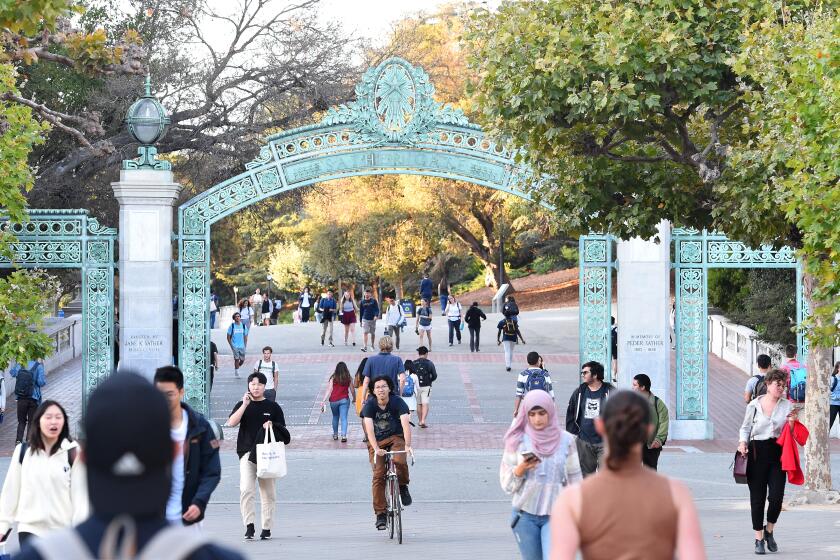The state needs a different approach to solving UC crowding

- Share via
The University of California’s plan to add 20,000 students by 2030 has led to conflicts with some of the communities where campuses are located, with residents complaining that the university system is not doing enough to house students, and are merely shifting the housing burden to them.
This dynamic is currently playing out in Berkeley, where a group of residents challenged the university’s growth plan, saying it would have an outsize effect on traffic, noise, rental prices and the environment. On Thursday, the state Supreme Court agreed, ruling that UC Berkeley could not admit the 3,050 additional students above its 2020 enrollment that it had planned for this fall without further environmental study. (That would have been an increase of a few hundred students over this year’s enrollment.) The university currently has about 45,000 students, a big increase from the fewer than 36,000 who attended in 2010.
For the record:
7:00 p.m. March 6, 2022An earlier version of this editorial gave a misimpression of the court ruling in the UC Berkeley case. The school would not be adding more than 3,000 students to its current enrollment, which is about 45,000; the judge used 2020 enrollment, when fewer students attended, as the baseline for measuring growth. Also, UC San Diego is planning two dormitory towers of 22 and 23 stories, respectively, not feet.
Neither UC Berkeley nor the residents are fully in the right. Residents say there aren’t enough dorm rooms to house thousands of new students in and around the city, and that is correct. Berkeley cherishes its low architectural profile — though there already are some high-rise dorms at the university — and is generally anti-growth.
The CEQA lawsuit stopping UC Berkeley from expanding enrollment shows it’s too easy to exploit California’s main environmental law.
Berkeley city residents also are right that the city, with its lack of open space, heavy traffic and parking problems, will feel negative effects from new housing the university plans to build, including a 12-story tower at iconic People’s Park, and the students, some of whom will inevitably have cars. But residents can’t have it both ways, saying there’s too little housing while the city is not building more to cover the shortfall.
Then again, building more dorms won’t necessarily solve the city’s housing crunch because students often find cheaper places to live off-campus. Having more than 45,000 students in a city with a total population of about 120,000 means some crowding, traffic and competition for lower-priced units in town.
A similar housing-related lawsuit has been contemplated at UC Santa Cruz, which expects to increase its enrollment by 9,000 students over the next 20 years. Last fall, UC San Diego, about the same size as UC Berkeley, had a 3,000-student waiting list for housing. Among its plans to build housing are two towers, 22 and 23 stories high, respectively. UC Santa Barbara’s recent response to the crowding involved plans to build a nearly windowless monstrosity of a dormitory.
UC is under pressure from the Legislature to enroll more students as demand grows. But although there is an element of NIMBYism in the protests against the thousands of new students being admitted, there’s no denying that the quick pace of growth has a serious impact on cities and the environment. Schools are developing plans for managing their enrollment increases largely by hiring more faculty and building more housing, as well as looking for opportunities to create satellite campuses. But even if residents welcomed all new construction and the students that come with it, adequate dorms — and classroom space and faculty and grad students to do the teaching — are at least a couple of years away.
Editorial: UC is at the tipping point with overcrowding. Don’t let it become an education factory
Kids sell spots in courses. A new dorm would be more like a windowless prison to pack in more students. Will the UC turn into a degree assembly line?
In other words, UC and the Legislature have to come to terms with the fact that they can’t just increase enrollment without having the space and infrastructure in place when more students arrive, not years later. Failure to do so affects not just neighborhoods but the quality of a UC education.
Crowding has led to a decline in student satisfaction with UC, the crown jewel of the state’s higher-education system. Some students can’t find classes they need and some are renting hotel rooms or living out of cars.
Already, UC Berkeley officials have said they will respond to the court’s decision in part by offering many of the students a fall semester made up entirely of online courses. That is not what students or the public have in mind as a University of California education.
The California Master Plan for Higher Education, the blueprint for providing a college education to all students who qualify and want one, calls for UC to enroll the top 12.5% of the state’s high school graduates. UC already is exceeding that responsibility, taking in the top 18% of students. But demand is increasing as more California students qualify for four-year public college.
The state missed a golden opportunity to take pressure off the UC system when it let California State University open a polytechnic school at what had been severely underenrolled Humboldt State. The school’s future is now set, at least until there’s time to see if this experiment works to boost enrollment at the Northern California campus. The school could have been converted to a UC campus much more quickly than building a new one. There’s still a chance to try converting a Cal State campus to a UC at Sonoma State, which also is experiencing declining enrollment. It makes little sense that some of the state’s institutions of higher education have to advertise to attract applicants while others are overfilled.
The state’s two public university systems will need to direct more applicants to campuses that can handle additional students. Not everyone can attend UC Irvine, UC Berkeley and UCLA. UC Merced still has capacity for more students, and obviously, so do some Cal State campuses. Dream schools may not be a dream if a student is crammed into a crowded lecture hall and sleeps in a car because there’s no housing available.
Until more housing is built and ready for students, the most severely crowded UC campuses should drastically reduce the number of out-of-state and foreign students, which make up 18% of undergraduates at Berkeley and some other campuses, in order to make room for Californians. This isn’t ideal. Not only do those students bring geographic and cultural diversity to UC, but the out-of-state tuition they pay helps fund the financial aid for low-income California undergraduates.
Newly introduced legislation would exempt most UC and Cal State housing projects from the California Environmental Quality Act, which has been criticized for allowing self-serving opponents of development to tie projects up in never-ending appeals. The bill is a good idea, but too broad as written right now. Some effects on communities, such as increased traffic or adequate parks, do matter and the legislation would virtually eliminate consideration of them.
Instead, the bill should limit the number and length of appeals for projects and set limits on community impact. Any large housing project is going to affect a town, but vague concerns about traffic aren’t reasons to stop much-needed dormitories from going up. More important: Would it take affordable housing away from longtime residents? Build on a park in an underserved community that has too little green space? Tie up streets with unacceptable levels of traffic?
The state Supreme Court ruling siding with local residents against UC Berkeley’s enrollment plans means that Gov. Gavin Newsom has to change course. He should view this as an opportunity to put the UC system on a more sustainable path by supporting a drastic reduction in the number of out-of-state students and immediately backfilling the budget to make up the tuition lost. He can use the borrowed time to help look for better long-term solutions.
More to Read
A cure for the common opinion
Get thought-provoking perspectives with our weekly newsletter.
You may occasionally receive promotional content from the Los Angeles Times.







